Itinerary for 1 Day in Lima, Peru | How to Plan Your Trip

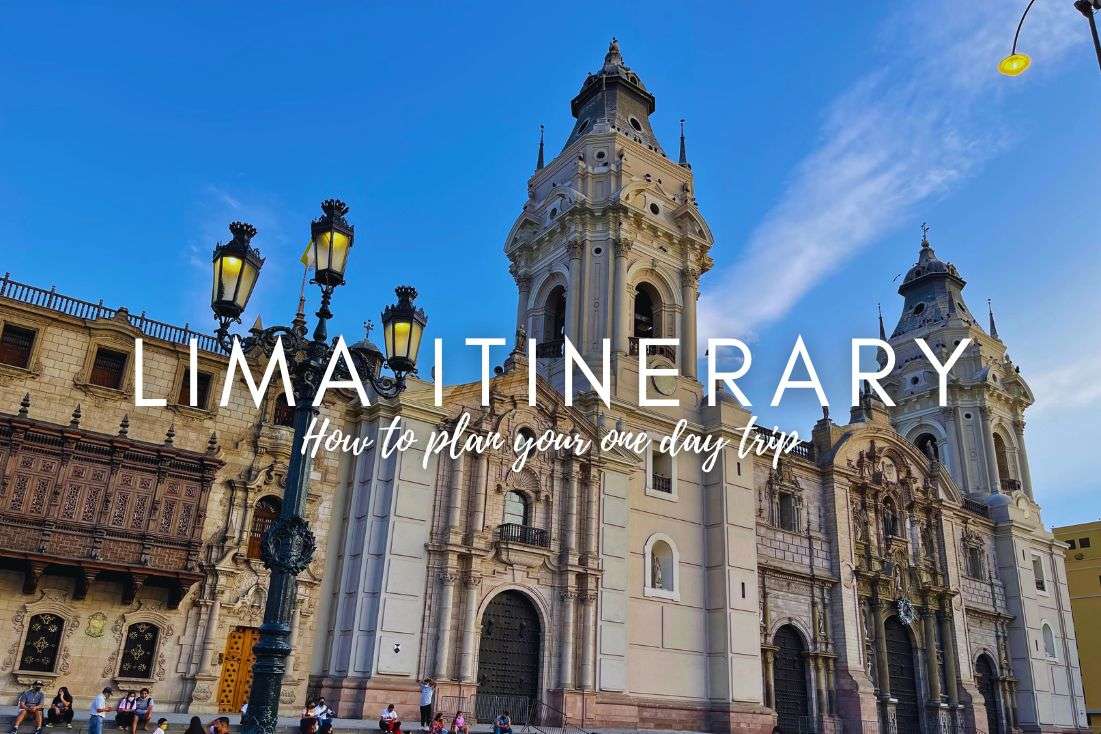
Peru has many spots that are very much worth your undivided attention, but Lima, its capital city, isn’t one of them. It’s a city of contrasts—one moment you’re marveling at colonial architecture, the next you’re clutching your seat as your taxi maneuvers through the city’s traffic—and to think I even tried driving in Lima!
To start, Lima airport has been one of my worst airport experiences to date! I also didn’t feel very safe, and I’m not easily discouraged on that front. But don’t let Lima’s reputation scare you off and skip Lima altogether. It’s hard to avoid even if you wanted to, because everyone arrives from their home country at Lima’s frustrating airport whenever they’re visiting Peru.
Don’t worry, there are ways to make your day in Lima a positive experience; following this itinerary is one of them. Make sure to stay in the Miraflores neighborhood. Take taxis and don’t drive. Eat lots of great food. And finally, set aside a good chunk of time for the incredible Larco Museum and your socks will be knocked off in no time!
This itinerary will guide you through 1 day in Lima, including all the practical details of getting from the airport, staying safe in Lima, and seeing all the right places from the historic center to the Pacific Ocean views. I’ve included your burning FAQs at the end of this article.
Lima one day itinerary trip plan + map
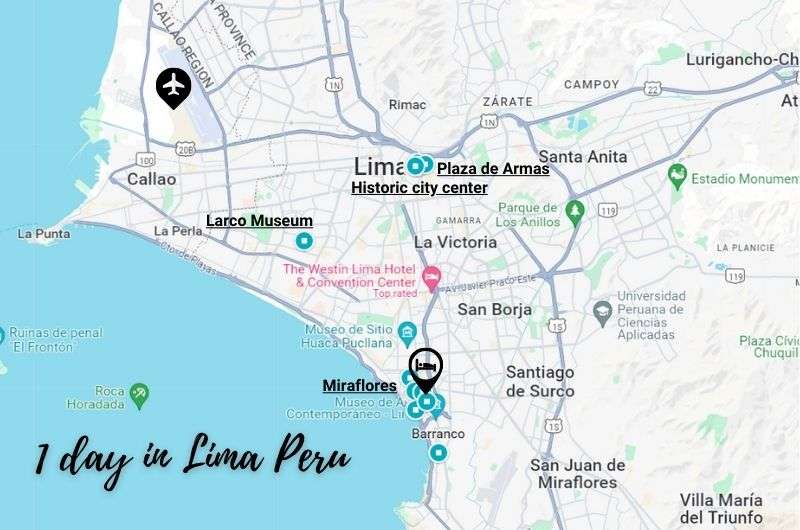
Take a taxi from the airport, book a hotel in Miraflores and explore Lima in one day
Ready to find out what to do in Lima for a day? This itinerary includes these stops:
Stop 1: Plaza de Armas Kick off your day where Lima’s history began. It’s grand, it’s got palm trees, and it’s full of nosy wooden balconies. Bonus: Plaza San Martin.
Stop 2: Convent of San Francisco Get ready for some serious Baroque vibes and a trip underground to meet 30,000 skeletons. Not creepy at all.
Stop 3: Museo Larco Epic doesn’t even cover it. Ancient art, jewelry, and some spicy pottery. You’ll love it and learn something weird, guaranteed.
Stop 4: Malecón in Miraflores Walk off the history with an early evening walk. Stroll atop Lima’s iconic cliffs with Pacific Ocean views that’ll make your jaw drop.
Stop 5: Larcomar Shop, dine, and soak up the Pacific breeze from a mall built into those famous cliffs.
Stop 6: Best Restaurants and Nightlife Taste why Lima is South America’s culinary capital, and maybe grab a cocktail or two in Miraflores’ trendy spots. Think ceviche and pisco sours.
Start checking out hotels now, ideally in Miraflores. It's the safest neighborhood in Lima.
Save it for yourself to come back to later, or share with your friends on social media!

Welcome to Lima, Peru’s capital city!
My top tips for visiting Lima, capital city of Peru:
- Where to stay in Lima? Definitely the Miraflores neighborhood. It’s pretty, it has parks and coastal views and all the infrastructure a tourist might need, and you won’t constantly be looking over your shoulder, even at night. I can vouch for both Radisson Red Miraflores and Hilton Lima Miraflores from personal experience.
- Don’t rent a car, the traffic in Lima is nuts. I don’t just mean it’s busy, I mean the drivers are crazy! Take the cheap taxis everywhere instead. Use Cabify.
- Eat ceviche as many times as you can. It’s Peru’s national dish and Lima is the best place to taste it! Over and over again.
- Get your SIM card in town, not at the airport. You’ll pay a ridiculous premium at the airport, while in Lima SIM cards are very affordable. Or, get an SIM.
What to expect in Lima?
Lima is the capital city of Peru and is a mix of historical sights, one unmissable, world-class museum, breathtaking coastal views, and ceviche (yes, that's raw fish). And that’s about it—the majority of Lima is an unsightly slum in the middle of the desert. With 11 million inhabitants, it's also the world’s third largest desert city, after Karachi in Pakistan and Cairo in Egypt. Let's just say it wasn't love at first sight when I visited Lima.
So, don’t linger too long, but don’t let any bad first impressions impact your opinion of Peru, because, as a whole, Peru is stunning! One of the must-visits of South America, no question. You must visit Peru, in case I'm not clear.
Lima is also the only place in Peru I didn’t feel safe, so I’ll get into the details of that in a bit, too. Speaking of which, see me mentioning homicide rates in 3… 2… 1…
Arrival at Lima’s frustrating airport
Your next challenge is getting from the airport to the city center. Lima’s Jorge Chávez International Airport is to the north of the city center in Callao, which is still relatively close to the main tourist neighborhoods, so you won’t spend too long stuck in traffic—though, in Lima, traffic is always a factor.
Safety tip: Don’t go leaving the airport to explore the local life in the Callao district. The homicide rate there is 12 per 100,000 population. Lima’s is around 8/100,000. Compare that to New York City’s 6/100,000. The most serious crimes are mostly committed between the locals and aren’t targeted at tourists, but still.
Anyway, welcome to Lima! Prepare yourself mentally for the incredibly slow pace of everything at Lima’s airport and the first glimpses of Lima’s shadiness. We waited 1.5 hours for our luggage to start appearing on the carousel! It’s particularly great if you’ve just spent the best part of 24 hours traveling on a delayed flight.
Then, we went to get a SIM card and were asked for USD 126 for two weeks. And finally, Hertz had the balls to say the rental car I reserved is gone and do I mind paying 3x as much for a worse one?! I almost turned around at this point and hopped on a plane back home.
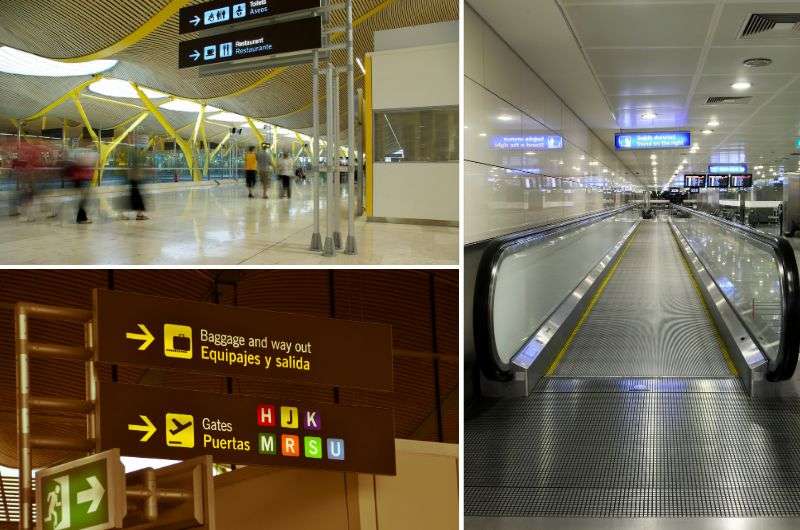
Lima airport
Tip: Lima airport has free wifi. Avoid purchasing a Peruvian SIM card at the airport! Wait until you're in the city to get much better deals.
Tip #2: Don’t rent a car at Hertz in Lima. Actually, don’t rent a car at all at the airport and just get a taxi into the city instead.
How do I get from the airport in Lima to the city center?
The best way to get from Lima airport to Miraflores or the historic city center is by taxi. Don’t even think about getting a rental car at this point; driving in Lima is a doozy and car rental companies are a joke! Read more about driving in Peru (with Lima specifics).
Other options that are safe are getting your hotel to send you a driver or taking the airport express bus (more about it below). Don’t take any regular public buses.
Distances from Lima airport to city center:
- Lima airport to Miraflores: 20 km (12 mi), a 30-minute taxi ride
- Lima airport to historic city center: 12 km (7 mi), a 20-minute taxi ride
- Lima airport to Barranco: Same as Miraflores, they’re right next to each other


Take a taxi from the airport to the city center
How much is a taxi from Lima Airport to Miraflores?
A taxi from Lima airport to Miraflores typically costs around USD 18 if you use a taxi app like Uber or Cabify, or up to USD 25 if you use the airport taxis.
For safety and convenience, I use Cabify in Lima to avoid haggling or misunderstandings. Of course, there are droves of taxi drivers that will try to get your business the moment you step into arrivals, but you don’t want to deal with them.
If for some reason you need to take a taxi at the Lima airport, go to one of the taxi desks inside the terminal and get your ride there. You’ll pay more than in an app, but at least you’ll have gotten your rate ahead of time and can be semi-certain the driver isn’t an undercover homicide percentage.

It’s the taxi driver from Home Alone, in case you were like “Where have I seen this guy?!” Or, from your taxi in Lima if you aren’t careful
Lima airport bus to Miraflores
An alternative is to look for the “Airport Express Lima” which offers direct routes to Miraflores, with modern buses equipped with wifi and USB chargers. The trip costs USD 6 per person but goes down to USD 4 when you’re booking with another person. You can buy tickets in advance or wait until you get to the airport and just wish for a spot.
Buses from the airport leave every hour on the hour between 7 am and 10 pm. The trip from Lima airport to Miraflores and takes about 45 minutes to an hour, depending on traffic.
The Airport Express Lima bus goes directly to Miraflores and makes 4 stops once there. The stop at the Larco Tourist Information Center is just a block away from Radisson Red Miraflores, one of the two hotels I can vouch for in Lima. Speaking of which…
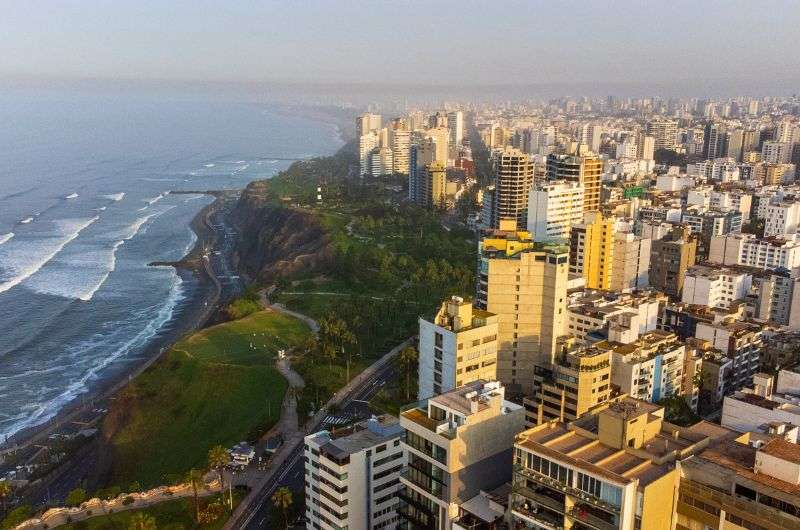
Miraflores, the best neighborhood to stay in in Lima
Where to stay in Lima? Hotels in Miraflores are your best bet
I highly recommend staying in the Miraflores neighborhood, a safe and upscale area frequented by tourists that’s perfect for both day and night exploration. It has all the tourist infrastructure you could wish for like restaurants and hotels, lovely parks and endless sea views, and streets you won’t be afraid to walk down even in the evenings. I would avoid staying in downtown Lima.
I personally stayed at and loved both of these hotels in Miraflores:
- Radisson Red Miraflores: If you’re into trendy, artsy vibes, this hotel’s modern design and rooftop bar will make you feel right at home. Oh, and red. You need to like the color red.
- Hilton Lima Miraflores: This hotel offers a tranquil escape with its fantastic rooftop pools, excellent breakfast, and quiet rooms—perfect for recovering from your flight.
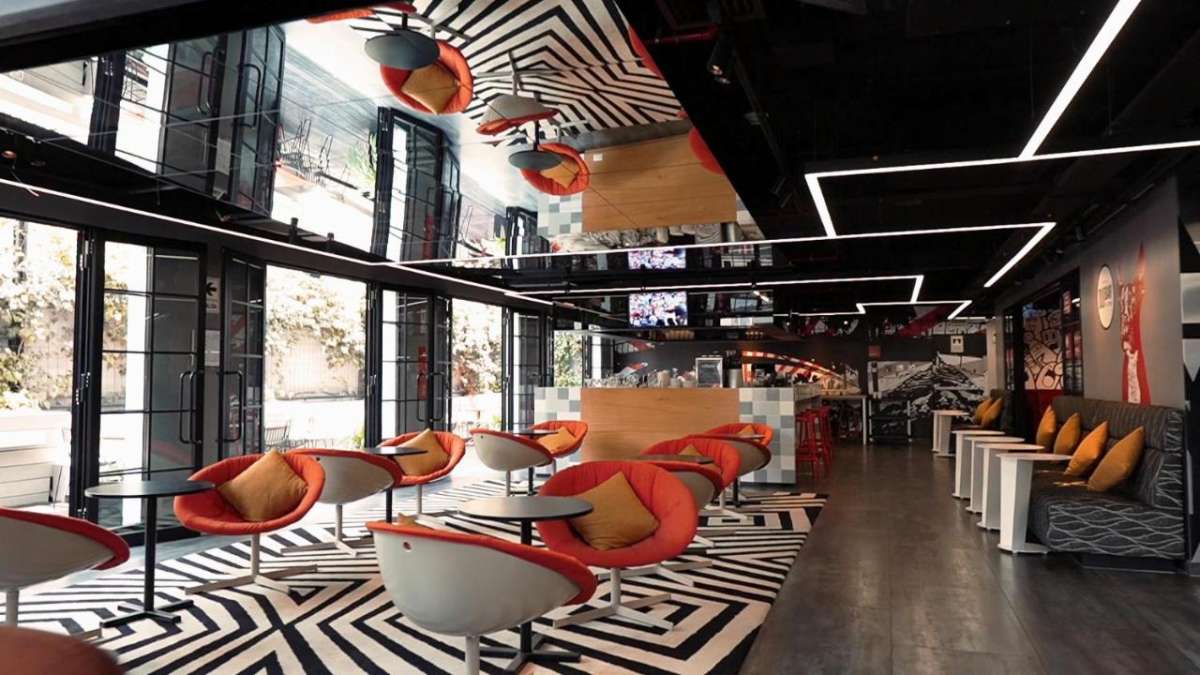
Some people opt to stay in Lima’s historic center, but I’m not some people. Go there to see some of the highlights, but you don’t want to base yourself there.
I’m also not a fan of Barranco, the neighborhood right next door to Miraflores. It’s supposed to be the bohemian neighborhood. To me, it just felt like a slightly nicer and much more colorful slum full of hippies. You see rustic, I see grimy.
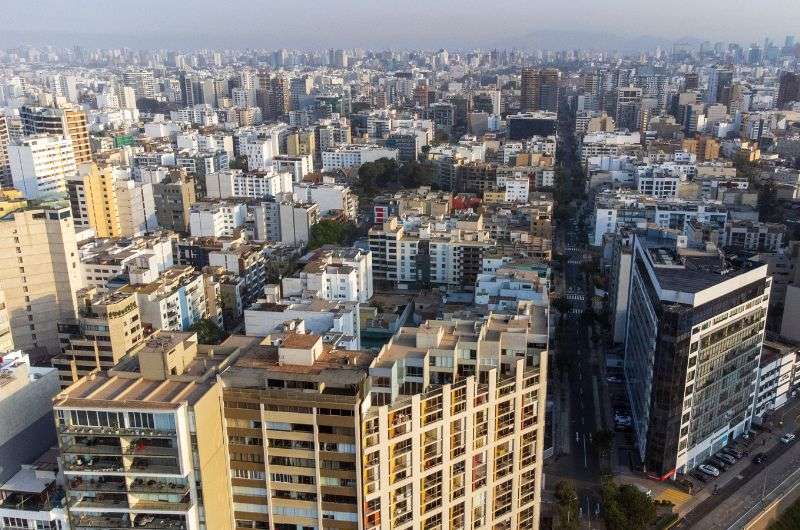
Find your hotel in Lima Miraflores
Hotel tip: For a stress-free stay, opt for international hotel chains known for their consistent quality, because local hotels in Peru are very much hit and miss. I am not typically a hotel chain kind of guy, but in Peru, I made an exception, and it was a good strategy.
Safety in Lima: Places to avoid
I’m not one to read the government’s travel advisories, freak out, and stay home instead. I’m pretty casual as far as safety goes, but Lima did not feel completely safe to me. The social differences and inequality are just too vast, and desperate people go to desperate measures, and the city has a somewhat tense energy because of it. Lima’s crime is mostly targeted at locals and is said to be pretty safe for tourists, but that doesn’t exactly mean you feel exempt from the shadiness.
During the day, it is totally fine, just have your wits about you as you would anywhere you travel. Of course, don’t do stupid things like heading out into the slums on your own. But Lima at night isn’t a place for a romantic midnight stroll through the alleys unless your idea of romantic is vastly different than mine.
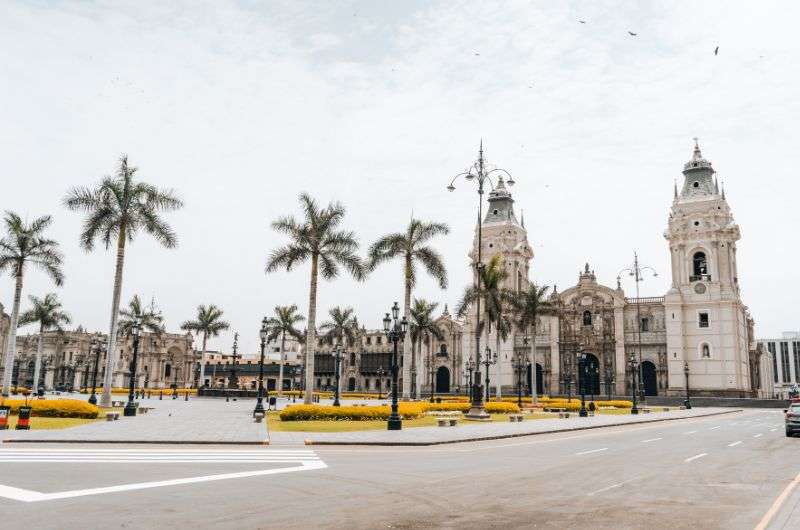
The south is safer than the north of Lima, but I’d just stay out of any alleys at night, no matter where you are
In general, the north parts of Lima are worse than the south, and the coastline is where the wealthy live, making it more comfortable for tourists. I had a lovely walk on the boardwalk in Miraflores, called the Malecón, that takes you on top of the cliffs over the Pacific Ocean one evening, and was content doing that. If you like a more relaxing evening, this is the place to be, as the sunset views are unbeatable.
And finally, let’s get into your detailed itinerary for 1 day in Lima:
Stop 1: Plaza de Armas and all the buildings on it
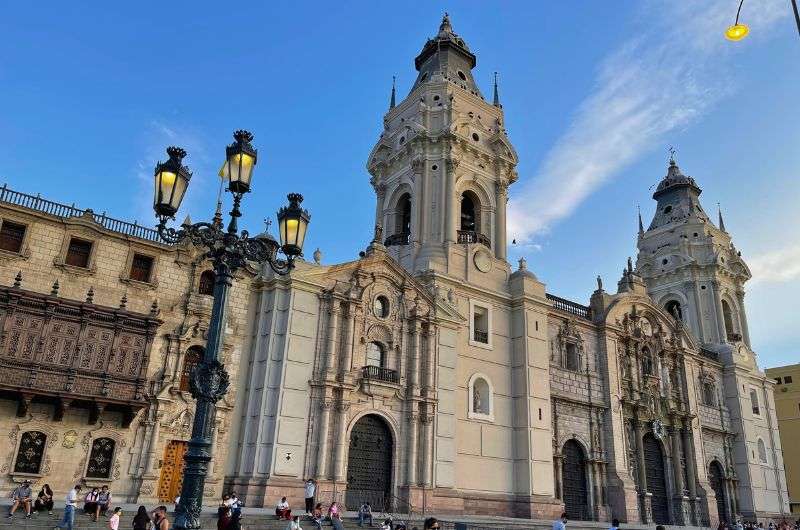
Plaza de Armas
- Distance from Miraflores: 10 km (0.2 mi), a 25-minute taxi ride (if there’s no traffic)
- Time spent here: 1 hour
- Price: Free for the plaza, see below for buildings
- Opening hours: See below
I said I wouldn’t stay in the historic center of Lima, but that doesn’t mean you’re not supposed to explore it! It is a UNESCO World Heritage Site, after all, and one of the city’s highlights. Downtown Lima, also known as Cercado de Lima or simply Lima Centro, is the historic and administrative heart of the city. It includes the area surrounding Plaza de Armas and stretches across a number of important colonial and government buildings.
First stop: Plaza de Armas—or Plaza Mayor if you’re feeling official—where Lima’s history began. You’ll need to take a taxi to get there and hope the trip takes close to 25 minutes and not an hour like it can in traffic.
What's with the name? In South America, Plaza de Armas and Plaza Mayor are basically interchangeable because, back in colonial times, the main square was where you’d find everything from military parades (hence "de Armas") to markets and gossip, making it the "major" hub of the city.
Plaza de Armas Lima is massive, with palm trees swaying gently in the breeze, framing a scene that’s as regal as it is intimidating. It’s not hard to imagine Spanish conquistadors strutting around here, feeling pretty pleased with themselves for claiming such a prime spot.
It’s a sizeable city square with a fountain in the middle and palm trees and manicured grass and curved flower beds going all around the edges. You can feel the life pulsating here. I liked it a lot.
Some of Lima's most beautiful colonial architecture is on display in the buildings surrounding Plaza de Armas. Many typically yellow buildings line the square, and they aren’t just cute, they’re the palaces where the important dudes sit—City Hall, the Government Palace, the Archbishop’s Palace and the Cathedral of Lima.
The wooden box balconies
UNESCO inscribed the historical center of Lima onto its Heritage List, and part of the reason why are the wooden balconies you’ll see on most of the buildings on the plaza and in the surrounding streets. They are “box balconies”, or balconies completely boxed in by carved wooden screens. They were a status symbol, as only wealthy families could afford them.
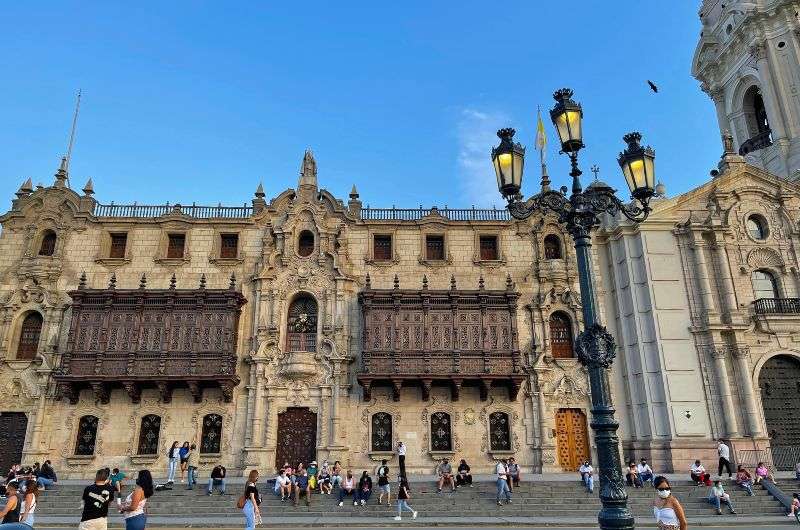
The wooden balconies on Plaza de Armas on Archbishop’s Palace
But what are they for? For being nosy and knowing what everyone in the neighborhood is up to! Really, the woman would be able to discretely hang out on the balcony, which would be covered in cushions, and watch what’s happening in the streets. Pre-social media, an ingenious way to stalk your friends and foes!
Historically though, this is an Islamic concept, and since Muslim woman aren’t meant to be seen by men outside their immediate family, the box balconies were a practical way for the ladies to go outside (well, sort of) without a care in the world. And spy on their neighbors.
Some of the screens have now been replaced with glass on some buildings, since nowadays people actually want to be able to see out of their living room properly. If you want to go be a cheeky lady and peek out of a screened box balcony, you can visit some of the historical buildings on the plaza, like the Archbishop’s Palace, and go out onto one.
Archbishop’s Palace
The palace is not only a residence but also a museum. Inside, visitors can explore a collection of religious art, historical artifacts, and beautifully decorated rooms that offer a glimpse into Lima's colonial past. But the obvious highlight of the Archbishop’s Palace are the intricate woodwork of the box balconies and then maybe the stained-glass windows.
- Opening hours: Tuesday to Sunday 9 am–5pm, closed Mondays
- Price: PEN 15 (USD 4) or PEN 20 (USD 5) as a combination ticket with the cathedral
Government Palace
The Government Palace looms over the square like it owns the place (which, technically, it does). If you hang around until noon, you can catch the changing of the guard, which is like watching a well-rehearsed, slightly intimidating dance. But you shouldn’t hang around until noon, because you have other things to visit. Chop, chop, you only have a day in Lima!
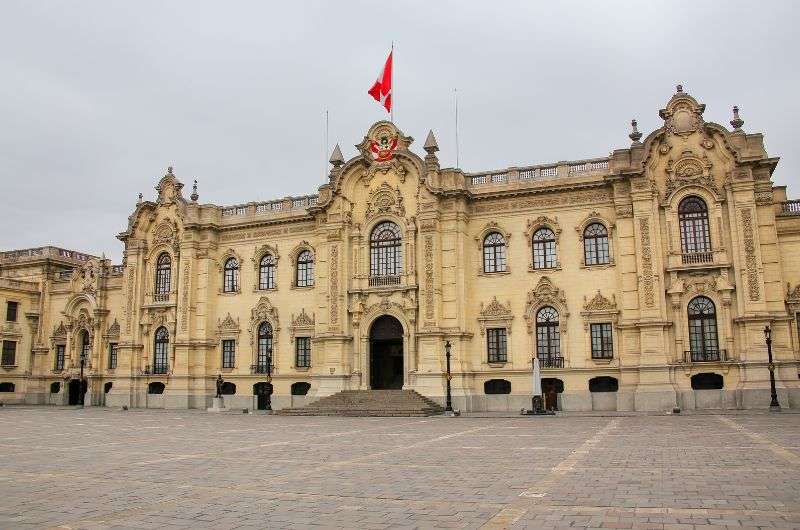
Government Palace of Lima
Lima Cathedral
Across the way, the Cathedral of Lima stands tall, its twin towers piercing the sky. Step inside, and you’ll find yourself surrounded by intricate woodwork (yes, again), massive altars, and the eerie silence that comes with centuries of whispered prayers. Because come on, this is Lima, the number of sinful souls must be staggering.
- Opening hours: Monday to Saturdays 9 am–5pm, Sundays 11 am–5pm
- Price: PEN 10 (USD 3)
The Municipal Palace and Casa del Oidor are also here, though not buildings that tourists can visit, but they also add to the plaza's vibe of “we’ve got history, and we know it”.

Lima Cathedral
How Lima was born
In 1535, Spanish conquistador Francisco Pizarro, following the set procedures of establishing cities in the New World, chose this location to build a plaza.
The procedure was simple: Decide where the main plaza of the new city will be and that will be the city’s center. Split land surrounding the plaza into parcels and give it out to other conquistador buddies, making sure the streets form a grid.
The Plaza de Armas is the plaza that Pizarro designated as the center, and Lima was born.
Bonus stop: Plaza San Martin
If you're a plaza enthusiast, Plaza San Martín is another one to add to your list. With its grand architecture and a statue of José de San Martín himself, it’s a slice of Peruvian history wrapped in neoclassical charm—perfect for a quick detour before moving on to your next stop in the historic city center.
Stop 2: Basilica and Convent of San Francisco | Price: USD 5, Opening hours: Daily 9 am–8 pm
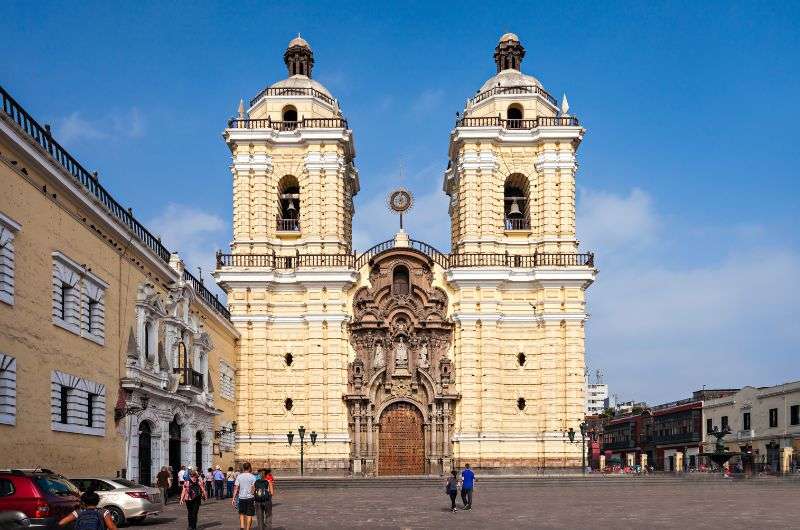
Basilica and Convent of San Francisco
- Distance from last stop: 350 m (0.2 mi), a 3-minute walk
- Time spent here: 1 hour
- Price: PEN 20 (USD 5) for a guided tour
- Opening hours: Daily 9 am–8 pm
Now, let’s move on to the Convent of San Francisco. Before you yawn, beware this isn’t just another church; it’s an entire religious precinct that even UNESCO has blessed with its approval. Just wait until you see the catacombs!
You can only visit on a guided tour that takes about 1 hour. Fair warning: the tour can feel a bit like a test of endurance if you get the wrong tour guide. Our tour was only in Spanish, and while my Spanish is pretty decent, the guide's monotone delivery made an hour feel like an eternity. Here’s hoping your experience is better!
For those who prefer English, tours are available, but it’s a first-come, first-served situation, and we weren’t bothered to wait and took the Spanish one that came up sooner instead. I obviously started regretting the haste about 5 minutes into the tour. But hey, the chance to explore one of Lima’s most iconic religious sites makes it all worthwhile.
But let’s focus on the good stuff. The interior is stunning, very churchy. The Convent of San Francisco is primarily built in the Baroque style, which was popular during the time of its construction in the 17th century. The convent's design features elaborate facades, intricate details, and grand arches, all characteristic of Baroque architecture.
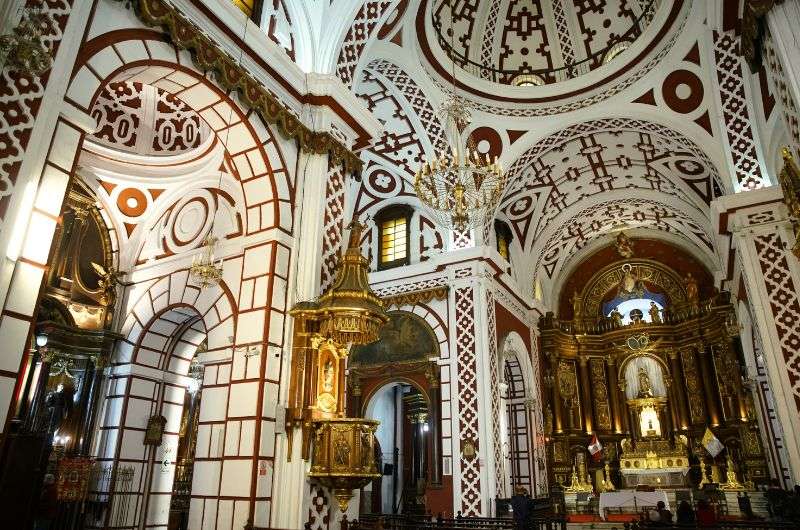
The Mudéjar style inside of the Basilica and Convent of San Francisco
It’s particularly famous for its stunning old library and the impressive Mudéjar-style dome inside the church, which is designed in the Mudéjar style—a beautiful blend of Christian and Islamic art that might remind you of the architecture in Spain’s Andalusia. It’s worth taking a moment to look up and appreciate the intricate woodwork. A shame you aren’t allowed to take photos inside.
The real highlight—or lowlight, depending on your perspective—is the tour’s grand finale: the catacombs. This is where the bones of some 30,000 real (but very dead) people are artfully arranged in patterns that are both fascinating and a little macabre. It’s definitely not something you see every day.
Stop 3: Larco Museum| Price: USD 10, Opening hours: Daily 9 am–7 pm
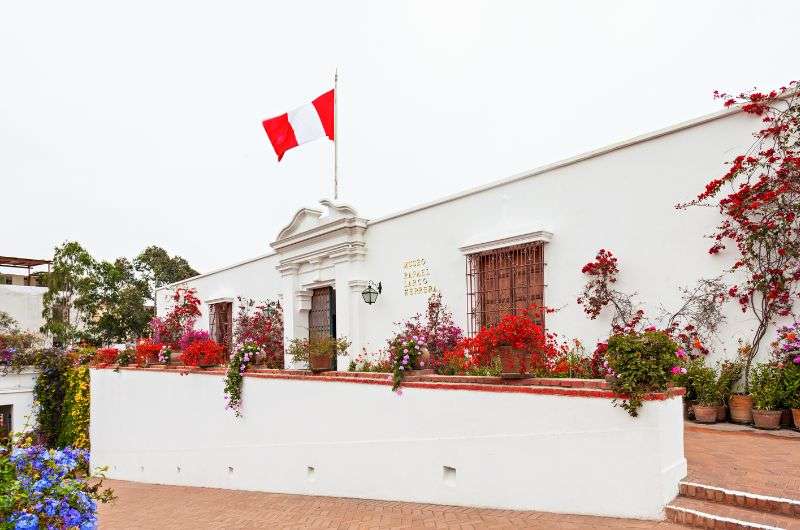
- Distance from last stop: 8–10 km (5–6 mi) depending on route, a 25-minute taxi drive
- Time spent here: 2 hours minimum
- Price: PEN 40 (USD 10)
- Opening hours: Daily 9 am–7 pm
- Website: Museo Larco website
No matter how cool the historical center of Lima is, my favorite thing to do was visiting Museo Larco—it’s nothing short of epic. Housed in a beautiful 18th-century mansion, this museum is a fascinating journey into ancient Peruvian history. It’s incredibly well-organized, with clear and informative descriptions that make you appreciate the brilliance of ancient civilizations while also scratching your head at some of their odd choices.
Getting to Museo Larco
And a quick note for the ambitious walkers: despite what Google Maps might suggest, don’t even think about hoofing it to the museum from Miraflores. It’s 10 kilometers (6 miles), and you’re still very much in Lima. Be smart—grab a taxi and save your energy for the museum’s treasures.
What’s inside the museum
The museum houses the vast private collection of Rafael Larco Herrera, who, through a mix of methods—some more ethical than others—acquired an astonishing array of artifacts. As you wander through the galleries, you’ll be wowed by ceramics, intricate gold and silver jewelry, textiles, and yes, the famous erotic pottery collection.
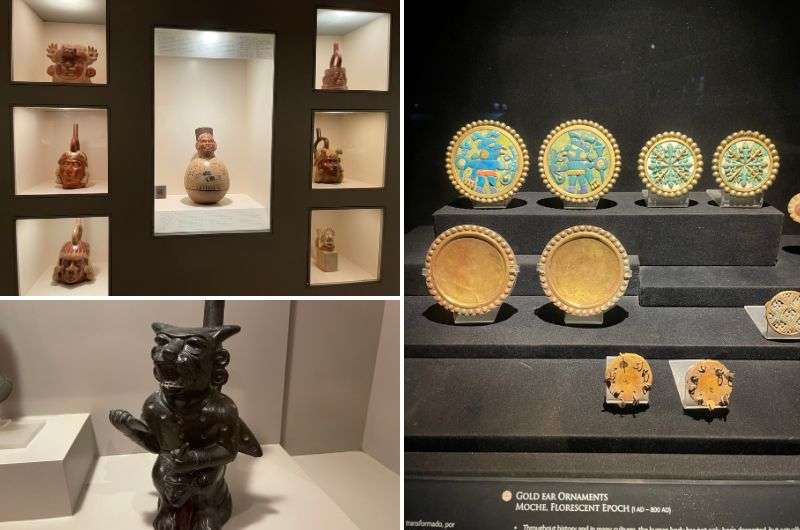
The exhibits in Museo Larco
Each room at Museo Larco is dedicated to a different ancient culture, giving you a chronological tour through Peru’s pre-Columbian past. But I came to wonder… while the craftsmanship is stunning, why, after centuries, some things didn’t evolve much? I mean it was fabulous when they made these things thousands of years ago, but when you see they were still making them in the 13th century, you can’t help but feel disappointed. I mean, the same jewelry designs from one millennium to the next? Come on, guys, where’s the innovation?
You’ll also learn some slightly disturbing tidbits, like how sacrifices were more valuable if the victim was wealthy or noble. And in the Inca worldview, the puma, condor, and snake symbolized different realms of existence—but ducks were the true MVPs because they could swim, walk, and fly. Who knew ducks were such big shots in ancient Peru?
The decorative head and face pieces made of various metals are incredible, not just because I can’t imagine those massive golden plates in my ears. Living back then must’ve really been something.
The Museo Larco also has a lovely café where you can relax with a snack while enjoying views of the garden from the terrace. Trust me, after about 2 hours inside the museum, you’ll need the break after soaking in all that history.
Stop 4: Miraflores and the Malecón boardwalk| Price: Free, Opening hours: Always open
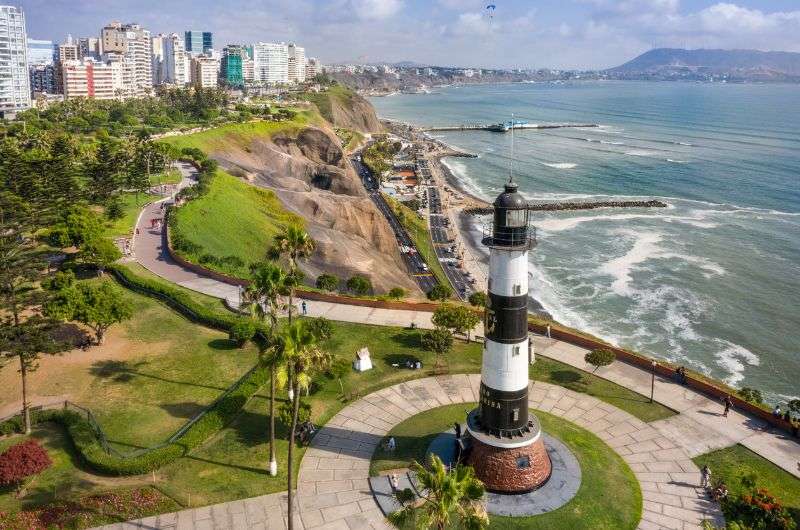
Lighthouse of La Marina and the Malecón boardwalk
- Distance from last stop: 8 km (4.8 mi), a 20-minute taxi drive
- Time spent here: 1 hour
- Price: Free
- Opening hours: Always open
Alright, you’ve done all the history and the ancient history that was in store for the day, now it’s time to breathe in some fresh ocean air with a stroll along the Malecón in Miraflores. This cliffside walk offers breathtaking views of the Pacific, where the landscape dramatically drops off into the ocean below. Miraflores itself sits atop these cliffs, which are covered in nets that help maintain the lush greenery growing on their steep faces—a unique sight and the most unforgettable view that you’ll get in Lima.
Start your walk at the Lighthouse of La Marina (Faro de la Marina), a blue-and-white structure that’s been guiding ships since 1900. If you’re in the mood for a touch of the exotic, you can begin your journey a few minutes west at the Chinese Park—but honestly, the whole area is a string of lovely parks, so pick your favorite and just go from there.
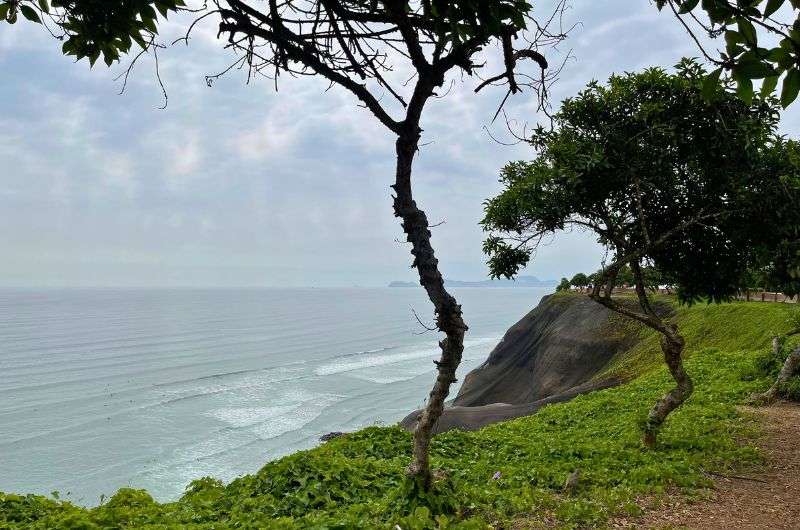
Afternoon walk along the cliffs
As you walk the 1.5 km stretch (if you started from the lighthouse), you’ll pass gardens, art installations, and maybe even a few adventurous peeps paragliding off the cliffs. Time it right, and you’ll catch the sunset painting the sky in vibrant hues, turning the ocean into a shimmering canvas. It’s the perfect way to end your afternoon… But not your day! I think you can still squeeze in one last stop in Lima!
Stop 5: Larcomar Mall with Pacific Ocean Views | Price: Free to walk around, Opening hours: Daily 6 am–10 pm
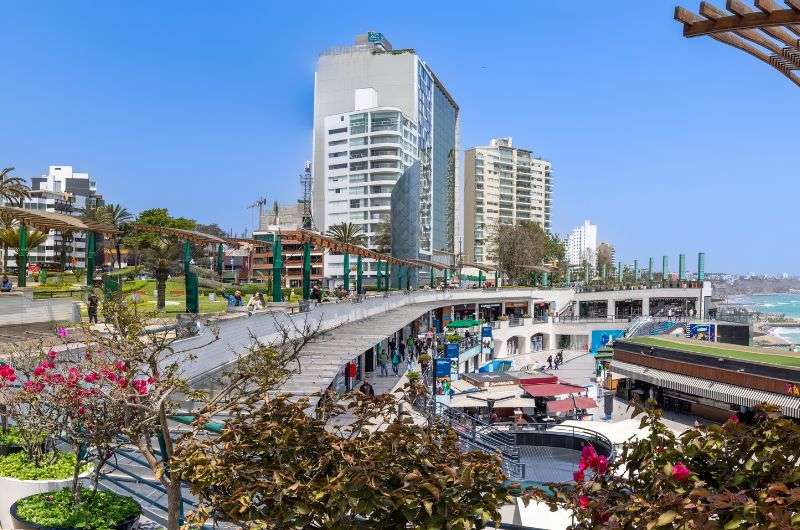
Larcomar Mall
- Distance from last stop: Larcomar is right at the end of your Malecón walk
- Time spent here: 1 hour + however long you need to finish your beer
- Price: Depends how much shopping you do
- Opening hours: Daily 6 am–10 pm (shops open later)
Finally, more ocean views? Why not? Is anyone really ever tired of those? But now, instead of walking and staring, let’s sit and stare, shall we? Or, if you prefer, shop and stare. Listen, to me, Miraflores looks a little like the nice parts of Miami and feels kind of like San Francisco, with tons of restaurants with delicious food, cafes, shopping, hotels, and great views. It’s the vibes, people.
One place in Miraflores that’s all the things is Larcomar—a mall/entertainment center that is built into Lima’s signature cliffs. It has an open plan, meaning the walkways are all outdoors and you feel the ocean breeze at all times, even when you’re browsing the newest collections at your favorite stores.
You won’t notice Larcomar right away when walking in the street because it is literally right under you, the top of the mall being at street level. So, look down or you’ll miss it! It is, not coincidentally, right at the end of your little Malecón walk.
Larcomar also includes plenty of dining options that come with an ocean view markup. Mangos Restaurant is the one we tried, and I have to say that while it serves mostly comfort food, the burger and Caesar salad were decent. Service is a bit slow, but hey, you can stare at the ocean while you wait.
On the other hand, you’re in the top foodie city in the World's Leading Culinary Destination, so you better get yourself a reservation in one of Lima’s top restaurants. Which brings us to…
Stop 6: Lima nightlife and best restaurants
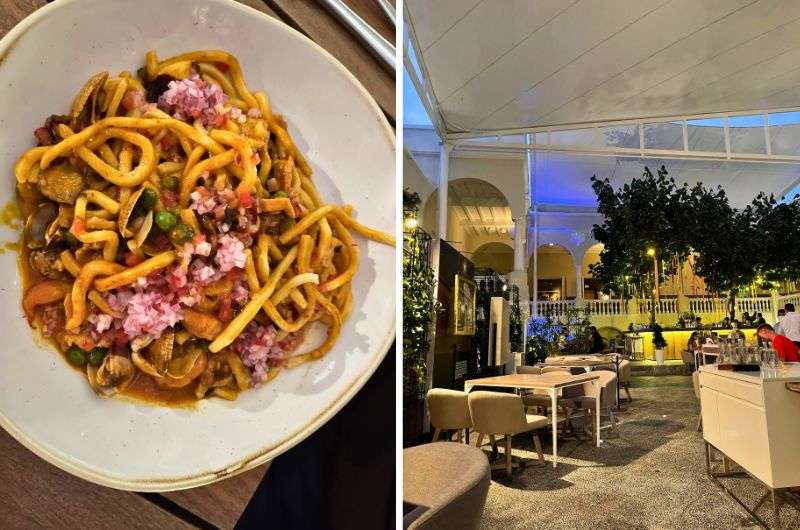
The Astrid y Gastón restaurant
I mentioned Peru has won the title of the World's Leading Culinary Destination yet again in 2024, but what really seals their superiority is that they won this title 10 times during the last 12 years (Argentina outcooked them twice)!
We had dinner at Astrid y Gastón, which placed in the top 5 best restaurants in the world the year we visited, and I really wanted to write about the best food of my life... but I ended up concluding that while the food was good, I’d drop their rating down to somewhere in the 200s. Well, I am now checking the 2024 best restaurants list as I write this, and Astrid u Gastón are gone! I see the judges have taken my opinions to heart, lol.
Lima’s current top restaurant? Maido—Peruvian food with a Japanese twist. Who would’ve thought. It’s a good option to try out a) because of the food, obviously, and b), because it’s just 2 blocks away from Radisson RED Miraflores, the hotel where I stayed and you should too. Especially since for me, stop 6 on this Lima itinerary ends in my bed right after dinner. What’s better than eating well and then not having to travel back across town to your hotel?
Lima Peru nightlife
I’m not a party animal and I think the best thing to do in Lima at night is stay the F in your hotel. They have bars too, you know. And pisco sours.
In general, Lima’s nightlife scene is more sitting and drinking rather than dancing until dawn, but that doesn’t mean it doesn’t have great nightlife. Miraflores and Barranco, two neighborhoods right next to each other, are the most popular and safest areas where you can get your drinks and/or moves on.
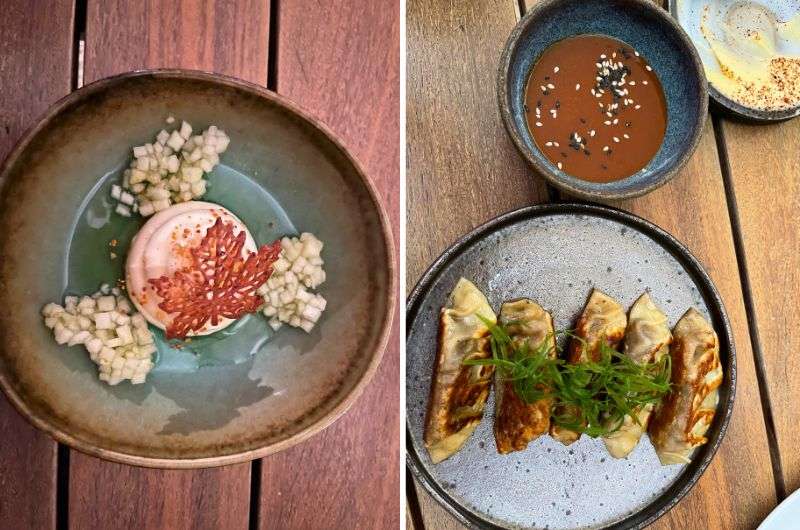
Try tapas in one of the great restaurants in Lima
You could try one of the top bars in Miraflores called Open Tapas Bar (what a boring name, huh?). It’s a tad upscale and you won’t be let in if you’re wearing board shorts and flip flops, which is a plus in my book. The drinks and vibe are great (if you’re a bar person).
I’ve already mentioned that I’m not a fan of Barranco, but it does have a pretty good choice of bars and I wouldn’t hate having a cocktail at Ayahuasca if you twisted my arm. It’s a restored villa from the 1800s and has multiple spaces and bars, both inside and in the courtyard. The décor is cool but classy and they have great food, too. There are more bars that aren’t dumps in the near vicinity of Ayahuasca, too.
And that’s all folks! If you were wondering what to do in Lima Peru for a day, you now know. A little bit of history, a little bit of city vibes, and the day is over.
Start checking out hotels now, ideally in Miraflores. It's the safest neighborhood in Lima.
Save it for yourself to come back to later, or share with your friends on social media!
What’s next?
I will be the first to tell you that Lima is worth one day maximum, because you need to head south as fast as possible, because that’s where Peru really becomes the star destination you’d hoped for. If you look at my 2-week Peru itinerary, you can follow the route I took, i.e. wake up bright and early in Lima and make the 3-hour drive to Paracas, one of my favorite places in Peru. Yes, that entails driving in Lima, which is an adventure in itself—I never sweat so much in an airconditioned car before!

Driving tip: Driving in Peru becomes better once you leave Lima. Not great, but better. And then you arrive in Arequipa and it’s like Lima all over again!
Speaking of Paracas…
FAQ 1: Can you do a day trip to Huacachina from Lima?
The sand dunes of Huacachina are incredible and are absolutely a top spot to see in Peru, but they aren’t exactly close to Lima. Some people do make the 4-hour drive out of Lima and then back in one day, but I’m not one of those people. I recommend making Huacachina a stop on your tour of the Paracas instead.
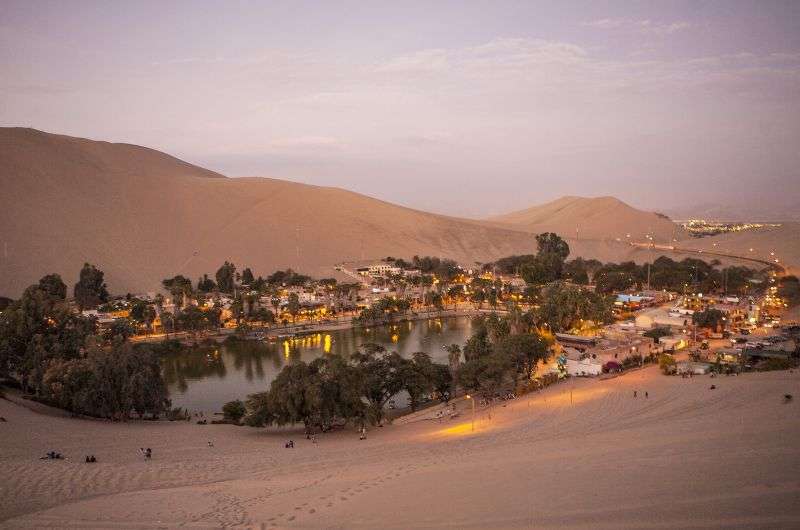
Huacachina
If you want to get sand stuck in all the wrong places much closer to Lima, do so in Lomas de Ancón with Desert Expeditions. The drive is just an hour to the north of the city. You’ll get driven to the dunes in a 4x4 vehicle, through the rough parts of Lima that you wouldn’t dare to enter by yourself. Once at the dunes, you can sandboard, sandski or sandsled.
FAQ 2: What to avoid in Lima?
Steer clear of sketchy areas like Callao, avoid driving in Lima (seriously, just don’t), and don’t wander off into unfamiliar neighborhoods or even just into little “romantic” side streets in the historic center at night. Stick to Miraflores and Barranco where you’re safer and can actually enjoy your time.
FAQ 3: Is Lima safe for tourists?
For the most part, yes, Lima is safe if you’re in the tourist areas and it isn’t nighttime and you aren’t wandering down any alleys. Does that seem restrictive? It is! I felt slightly uneasy in some parts of Lima, I’m not going to lie. That’s why I urge everyone to stay in Miraflores, which felt safest and is where many tourists stay. Always keep your wits about you and avoid nighttime strolls down dark alleys—this isn’t a Netflix thriller.
FAQ 4: Is it safe to take a taxi in Lima?
It can be, but only if you use Cabify like I did (or another taxi app of your choice). Why? Because you get a set price so you aren’t stuck arguing with someone you don’t want to be arguing with, the drivers are vetted, and you won’t end up in a dodgy situation. The airport taxis are generally fine too, just avoid the unmarked cars like the plague and book your trip to the city center at the kiosks inside airport arrivals. Or, ask your hotel to get you a taxi.
FAQ 5: What food is Lima famous for?
Peru’s national dish, ceviche, is not what I would typically opt for, but Lima did it well and not kidding, on some days, I ate it twice. Ceviche is a dish made from raw fish marinated in citrus juice, most often served with sweet potato and corn. So healthy, so fresh, so good!

Come and taste the food of Lima
FAQ 6: How long should I spend in Lima?
One day in Lima is plenty to hit the highlights, eat amazing food (ceviche!), and escape before the traffic consumes your soul (and someone steels your wallet). Trust me, you won’t miss much by moving on quickly. Any more, and you’ll be wondering why you’re still here when Cusco and Sacred Valley are calling.
FAQ 7: Should I spend more time in Lima or Cusco?
Cusco wins over Lima, hands down! Lima is a one-day stop, max. Cusco is where the magic happens—think ancient Mayan ruins, epic mountainous landscapes, and way fewer honking horns.
FAQ 8: Is there a train from Lima to Cusco?
A train? From Lima to Cusco? That’s like asking if you can zipline across the Andes! It’s not just impossible—even driving the 1,000+ km (700 mi) to get there would take 20+ hours non-stop through mountains, deserts, and who knows what else. Unless they start building a 1,000 km tunnel anytime soon, do yourself a favor and book an internal flight. Flying is the only sane option, people! LATAM Airlines is South America’s top airline, so you should be good. Much better than on the ground.
This post contains affiliate links. I earn a small commission if you make bookings through my links, at no additional cost to you. Thank you for your support!










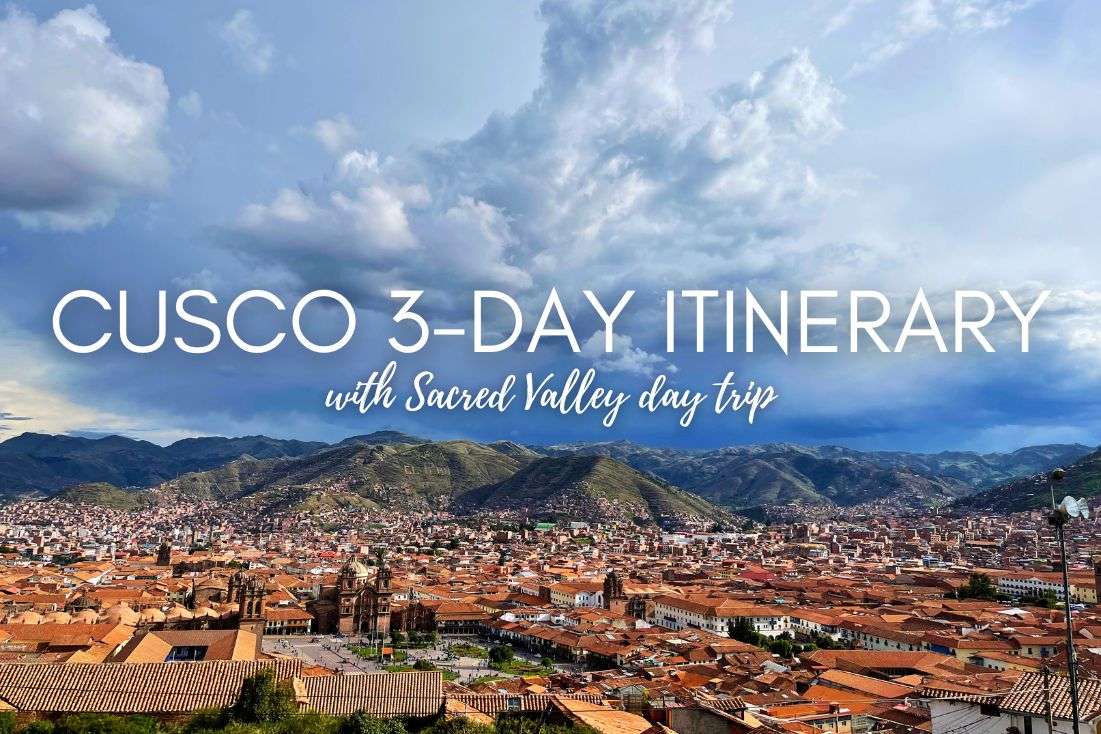
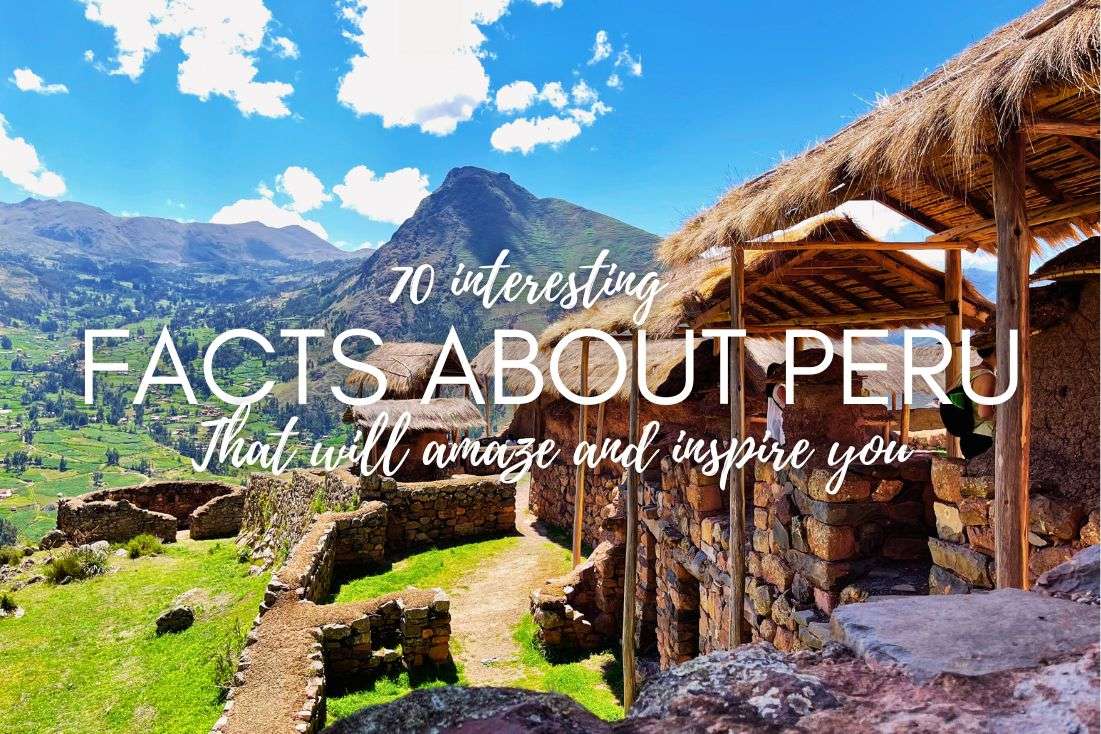




Comments | Thoughts? Give us a shout!